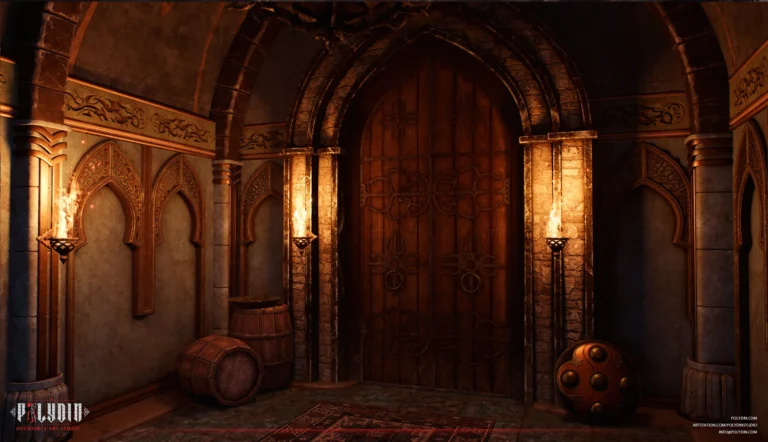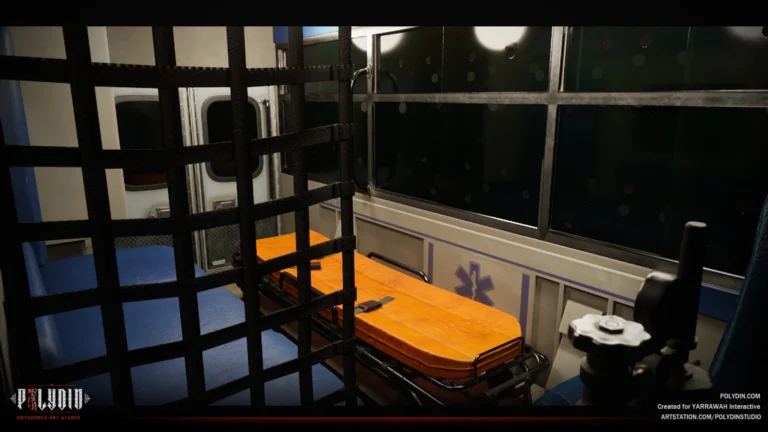In today’s thriving independent game development scene, having the right tools can make all the difference between a passion project that struggles and a polished title that captures attention. Whether you’re a solo developer or part of a small team, access to efficient, affordable, and powerful software is essential for bringing your vision to life. That’s where The Ultimate Guide to Indie Game Developer Tools comes in.
This guide by Polydin game art outsourcing studio is designed to highlight the most effective and widely-used tools across every stage of game development—from 3D modeling and illustration to audio editing and version control. We’ve curated a list of standout software solutions that strike the right balance between quality, usability, and cost, with a special focus on free or low-cost options that don’t compromise on features.
The Essential Tools for Indie Game Developers
Here are the essential tools that every indie game developer should know about.
Blender – 3D Modeling and Animation
Blender is one of the most powerful and versatile tools available to indie game developers today—and the best part is, it’s completely free. As an open-source 3D creation suite, Blender covers the full pipeline: modeling, rigging, animation, simulation, rendering, compositing, and even video editing. For indie teams operating on tight budgets, it’s an invaluable resource.
One of Blender’s standout features is its intuitive interface and extensive customization options. Artists can switch between sculpting, low-poly modeling, or procedural workflows depending on the project’s needs. It also boasts a robust animation system with support for rigging, shape keys, constraints, and an advanced graph editor for precise control.
For indie developers, Blender is especially attractive because it delivers professional-quality results without licensing fees. Frequent updates from its active development community ensure it remains cutting-edge. Add-ons like BlenderKit and asset libraries streamline asset creation, and seamless export options make it easy to bring models into engines like Unity or Unreal.
What makes Blender shine in The Ultimate Guide to Indie Game Developer Tools is its scalability. Whether you’re building a stylized 2D/3D hybrid or a full-blown 3D world, Blender can handle it. Its thriving global community also means tutorials, plug-ins, and support are readily available. From creating textured characters to cinematic animations, Blender empowers indie creators to punch well above their weight.
Krita – Digital Painting and Illustration
When it comes to creating stunning 2D art, textures, and concept illustrations, Krita is a favorite among indie game developers—and for good reason. This open-source painting program is built specifically for digital artists, offering a deep set of features without the high price tag of commercial alternatives. In The Ultimate Guide to Indie Game Developer Tools, Krita earns its place as a go-to option for everything from UI elements to hand-painted textures.
Krita’s brush engines are among the most flexible and powerful in the industry, allowing artists to customize virtually every aspect of their tools. Whether you’re painting backgrounds, designing characters, or creating stylized effects, Krita adapts to your workflow. It also supports high-resolution canvases, HDR painting, and color management, making it suitable for professional-quality output.
Its animation capabilities, though not as extensive as specialized software, are a welcome bonus—especially for indie developers creating sprite sheets or frame-by-frame animations. Krita also supports layer groups, non-destructive editing, and full PSD compatibility, making it easy to collaborate across multiple tools and pipelines.

One of Krita’s biggest strengths is its artist-focused UI, which feels intuitive right out of the box. The community surrounding it is active and generous, providing brushes, templates, and tutorials that help shorten the learning curve.
For developers looking to bring a distinct visual identity to their games, Krita is not just a painting tool—it’s a creative powerhouse. That’s why it remains a standout entry in The Ultimate Guide to Indie Game Developer Tools.
Houdini – Visual Effects and 3D Animation
Houdini is a powerhouse for procedural generation, particle effects, and cinematic visuals—typically associated with big-budget productions. But thanks to its free “Houdini Apprentice” version and non-commercial indie license, it’s increasingly becoming an accessible tool for small studios and solo developers. In The Ultimate Guide to Indie Game Developer Tools, Houdini earns a place for its ability to generate complex visuals with remarkable control and efficiency.
What sets Houdini apart is its node-based workflow, which allows developers to build highly customizable and reusable systems. Whether you’re simulating realistic fire, generating destructible environments, or creating dynamic cloth and fluid effects, Houdini’s procedural nature means you can iterate quickly and avoid repetitive manual adjustments.
For indie game developers, Houdini is especially valuable in areas like environmental art and visual effects. Want to populate an alien landscape with thousands of rocks and plants? Houdini can do it procedurally. Need a crumbling ruin or a collapsing bridge? Its physics simulations handle it without scripting custom solutions from scratch.
Though there’s a learning curve, the long-term payoff in flexibility and scalability is significant. The community offers extensive tutorials and pre-built digital assets, and Houdini can export to game engines like Unreal Engine with tight integration via tools like Houdini Engine.
In short, Houdini allows indie developers to achieve AAA-level VFX and animation complexity without the overhead of a large team. That kind of visual polish makes a huge difference—and that’s why it’s firmly featured in The Ultimate Guide to Indie Game Developer Tools.
Mixamo – Character Animation
Mixamo, a free online platform from Adobe, is a game-changer for indie developers who need animated characters fast. With its auto-rigging capabilities and an extensive library of motion-capture animations, Mixamo dramatically reduces the time and technical expertise needed to bring characters to life.
In Indie Game Developer Tools, it earns a solid spot for being one of the most efficient ways to get from a static model to an animated asset.
The process is straightforward: upload your 3D character model (commonly from Blender or other 3D software), and Mixamo will automatically rig it with a skeleton. No manual bone placement, weight painting, or IK setup required. Once rigged, you can apply hundreds of pre-built animations—walking, fighting, jumping, dancing—and download them for immediate use in engines like Unity or Unreal.
What makes Mixamo particularly valuable for indie projects is its accessibility. You don’t need to be a technical animator or have a background in mocap to create convincing movement. It’s especially useful for prototyping gameplay or building character-centric projects without a large animation budget.
While it doesn’t offer deep customization or fine-tuned control compared to full animation suites, its speed and simplicity make it an ideal supplement to more robust tools. Many indie teams use Mixamo to cover animation needs while focusing their time and resources on gameplay, narrative, and visuals.
In a fast-paced development cycle, tools that save time without compromising quality are essential. That’s why Mixamo deserves mention in The Ultimate Guide to Indie Game Developer Tools.
Audacity – Audio Editing
No game is complete without sound. Whether it’s ambient background noise, dialogue, or a crunching footstep, audio is what gives a game its atmosphere and emotional impact. For indie developers looking for a robust, no-cost solution, Audacity is one of the best tools available—and a worthy entry in The Ultimate Guide to Indie Game Developer Tools.
Audacity is a free, open-source audio editor that’s surprisingly powerful given its minimal footprint. It supports multi-track editing, real-time effects previews, and essential tools like noise reduction, reverb, compression, and equalization. For solo devs or small teams, it can handle the entire workflow of recording, editing, and mastering game audio.
One of Audacity’s standout features is its accessibility. Even with little to no audio engineering experience, developers can quickly learn to clean up voice recordings, trim sound effects, or mix background music with professional polish. The UI is simple, with drag-and-drop functionality and a variety of keyboard shortcuts for efficient editing.
Whether you’re working with original recordings or editing samples from a sound library, Audacity’s toolset makes it easy to fine-tune your game’s audio identity. It also supports a wide range of plugins and file formats, ensuring compatibility with other tools and engines.
Audio can often be overlooked in early-stage game development, but it’s essential for immersion and feedback. Audacity empowers indie creators to deliver compelling, clean soundscapes without spending a dime.
Helix Core – Version Control
As indie game projects grow in complexity—especially when multiple collaborators are involved—keeping track of assets, code changes, and project history becomes critical. This is where Helix Core steps in. A professional-grade version control system (VCS) built for handling large files and collaboration, Helix Core is a vital entry in Indie Game Developer Tools.
Unlike Git, which can struggle with massive binary files common in game development (like textures, audio, and 3D models), Helix Core is optimized for performance under these conditions. It allows teams to manage and store large assets efficiently, track every change made across the project, and revert to earlier versions with confidence. Even for solo developers, having version control means never losing progress due to a bad export or crash.
Helix Core supports branching and shelving, which are crucial when testing features or collaborating without interfering with the main project. Its integration with major game engines, including Unreal Engine and Unity, makes it even more practical for daily use. Plus, developers can access their files remotely, essential for remote or hybrid teams.
While setting up Helix Core might seem more technical than other tools in this guide, the time saved in the long run, by avoiding lost work, miscommunication, or accidental overwrites, is immeasurable. That’s why it’s not just for AAA studios anymore.
Bonus Mention: Choosing the Right Game Engines
No discussion of indie game development tools would be complete without touching on the engines that bring everything together. While this article primarily focuses on asset creation and support tools, it’s worth briefly highlighting how engines like Unity and Unreal Engine integrate with the other entries in The Ultimate Guide to Indie Game Developer Tools.

Unity is renowned for its flexibility, vast asset store, and large community, making it a go-to choice for 2D and mobile games. Unreal Engine, on the other hand, offers photorealistic rendering and powerful built-in tools, ideal for 3D and cinematic projects.
Both engines support easy import workflows: Blender models drop in with minimal effort, Mixamo animations are readily compatible, and Houdini assets can be dynamically linked using plugins. Likewise, tools like Audacity and Krita feed directly into content pipelines for sound and visual assets.
Ultimately, the best engine is the one that complements your team’s strengths and your game’s vision. Choose wisely—and make your tools work together.
Conclusion
In The Ultimate Guide to Indie Game Developer Tools, we’ve covered a range of essential software that can streamline the development process, enhance creativity, and save valuable time. From Blender’s powerful 3D modeling capabilities to Audacity’s detailed audio editing, each tool is pivotal in bringing indie game visions to life.
Whether you’re creating assets, programming game logic, or fine-tuning animations, these tools allow indie developers to achieve professional-quality results without breaking the bank. Tools like Krita and Mixamo offer specialized features that cater to both 2D and 3D workflows, while Houdini’s cutting-edge visual effects elevate your game to AAA standards. Helix Core ensures that you can collaborate and manage your project effectively, even with large teams.
Ultimately, the combination of these tools provides indie developers with the flexibility, control, and resources needed to create amazing games. By using these tools wisely, you’re well on your way to turning your creative vision into reality.



